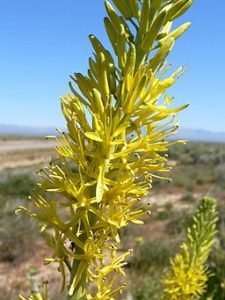Metal Eating Plants Clean the Earth
Metal eating plants can clean the earth–how exciting! You’ll find a wonderful video about heavy metal eating plants down below.
For me, this news about heavy metal eating plants is especially exciting. I received information from Pan, Lord of the Wilderness, while writing my book, When We Were Gods. He said that nature was capable of cleaning the earth. I included the information in the book, When We Were Gods. Here’s a quote from the book:
“But remember, Pan has also said that nature can and wants to heal the earth.”

Flowers of Stanleya pinnata, one of the Heavy Metal Eating Plants. Photo by Stan Shebs. Photo available through Wikipedia Commons.
When this information came to me, I assumed this meant the usual. Plants absorb carbon dioxide, a greenhouse gas, and produce oxygen.
However, a Wikipedia article on the heavy metal eating plant, Pycnandra acuminata, shows another way of healing the earth. Interestingly, the article describes a use of the plant in cleaning up polluted former mine sites:
Such plants are of considerable interest due to their potential use in phytoremediation of heavy metal contaminated former mine sites
It didn’t occur to me that there could be plants that pull heavy metals out of the soil. Talk about cleaning the earth!
By the way, if you’re interested in learning more of what Pan said, I’ve included a link to the Amazon listing of the book here:
Take a look at this YouTube video of botanist Dylan Burge, PhD, at the California Academy of Sciences. He is doing research on species of plants that naturally soak up or “mine” heavy metals from the soil. They are called hyperaccumulators. In the video, he specifically talks about a plant on the island of New Caledonia, which he calls an arc of bio-diversity. The island is off the east coast of Australia and is home to almost 200 species of metal eating plants.
Dr. Burge describes Pycnandra acuminata, the plant mentioned in the Wikipedia article sited above. The video shows an amazing image of the plant, which is in the same plant family as the rubber plant. However, the rubber sap of the Pydnandra acuminata is a light blue color that contains 26% nickel. This metal eating plants soaks up nickel! Interestingly, nickel is a light blue color.
Dr. Burge also mentions Stanleya pinnata, which hypaccumulates selenium. It’s a plant that grows in the American Southwest, and can be deadly to livestock that eat it. Nonetheless, if you wanted to clean earth polluted by selenium, you could use Stanleya pinnata. This is a great video: